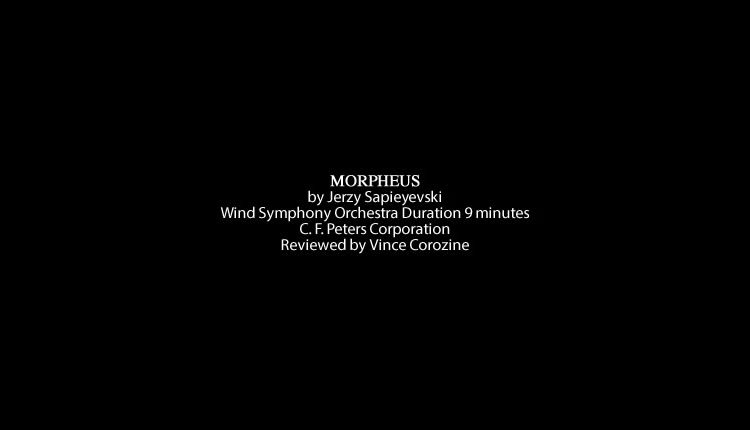MORPHEUS
by Jerzy Sapieyevski
for Wind Symphony Orchestra
Duration 9 minutes
C. F. Peters Corporation
Reviewed by Vince Corozine
Instrumentation and seating chart are suggested at the start of the score. The score is neatly hand-written with suggestions for a minimum number of instruments to be used in the performance of the piece.
The score is marked Allegro ritmico (MM quarter note=120)
The composition’s range of dynamics is from a hushed pianissimo to a full-sounding
fortissimo.
This is a mood piece with a contemporary impressionistic sound…..very transparent in texture using plenty of tension and floating sonorities that are suspended in space. At times, the composer employs the sound of pentatonic flavoring. There is an abundance of independent playing with very little doubling-up of parts. The entire composition sounds like a nebulous object hovering in space…and it requires the abilities of excellent players.
The percussion parts are complex and very demanding. Parts include marimba and two additional percussionists, besides the timpani. The parts are carefully marked with dynamics and expression marks.
An unusual, but effective sonority is created with the harp doubling the timpani notes. The composer employs the use of many sforzando notes to achieve unique rhythmic effects. Most of the sforzando notes are reinforced by the slapstick and woodblock. This combination adds a bright, percussive edge to the sound.
At times, the harp also doubles the theme with the first trombone combined with the low pedal tones of the bassoon and contra bassoon. Parts moving at different speeds is always a captivating device.
The composer uses sustained ninth chords with the third of the chord voiced in the lowest horn, as well as he employs the use of polytonality and tri-tone relationships. His use of terraced dynamics (adding instruments one or a few at a time), moving from a pianissimo to a full-bodied fortissimo to achieve a massive crescendo from the volume level p to fff is extremely effective.
A solo trumpet emerges playing a poignant melody in fourths (Bb, Eb, and Ab). Earlier in the score, the composer assigned these very notes as part of the theme played by the harp, and trombone.
The instrumental texture created by harmonics played by the harp, combined with the flute and first bassoon, create a strange tonality. This effect builds effectively, by increments, coupled with the sound of sweeping runs in the woodwinds culminating in a very dissonant bitonal chord. The piece ends quietly.
This is an extraordinary, contemporary-sounding composition, with many impressionistic daubs of instrumental color, unusual combinations of instruments, and challenging rhythmic interplay.
The first horn ascends to a written high Bb above the staff, while the trombones descend to a low G, F, and E. The clarinets are written to the Ab in its altissimo register.
The instrumentation if piccolo, 2 flutes, oboe, clarinet in Bb, 2 bassoons, 1 contra bassoon, 5 horns in F, trumpet I (3 players), trumpet 2 (2 players) 2 trombones, tuba, harp, timpani, marimba, and 2 percussion parts.
Morpheus is a challenging piece of music, recommended only for the highest level of musicianship. Its contemporary impressionistic flavoring, exotic effects, and unexpected sonorities make this a fascinating piece to program.


